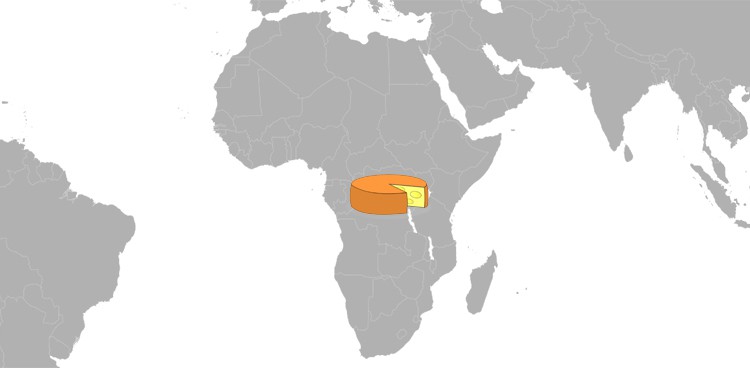
Deep in the eastern hills of the Democratic Republic of Congo, a region of the Masisi Mountains has been given a very curious nickname. Known as “The Switzerland of Africa”, this area is home to a fairly large population of Swiss Brown and Freisländer cows—two breeds that are native to Switzerland but were brought over during colonial Belgian rule (1908–1960). However, it wasn’t until 1970 that Belgian monks introduced cheesemaking to the people of the Congo after missing the readily available supply of Alpine cheeses from their home country. Fast-forward fifty years, and cheesemakers in this region are thriving, despite having survived decades of tumultuous warfare.

Photo Credit: “Gouda Congo Cheesemaking” by Getty Images | takepart.com
The most popular cheese made in this area is called Masisi Gouda, or “Goma”, named after the provincial capital about 25 miles west of the mountains. It’s very similar to a Dutch gouda but has a softer texture and is milder taste. While this cheese is by far the most widely produced, many cheesemongers dream of returning to the old days where many different kinds of cheeses used to flow out of their shops. For many small dairy farms, the technical skills of the farmers are bogged down by a lack of necessary equipment, as years of living in a war zone have caused many cheesemakers to work out of bathtubs, buckets, and metal pots.

Photo Credit: “Cheese makers stir hot water and cheese curds in a bathtub” by “BBC” | “takepart.com”
For many Congolese cheesemakers, their careers began when the UN Food and Agriculture Organization (FAO) started a program to teach locals all of the necessary skills to be a good cheesemaker. From there, many Congolese men and women went to work at the factories started by the Belgian monks, producing various dairy products in the style of Italian mozzarella and French Camembert. However, in the late 1990s numerous cheesemakers were forced to leave the Masisi Mountains when war destroyed the industry and forced them to flee. It was not until November of 2013 that the Congolese army defeated the M23 rebels after receiving military assistance from U.N. troops. While the threat of danger is far from over, many Congolese who were displaced by the war have begun to return home.
While cheese is not a traditional part of an African diet, the abundance of cattle and the cool climate of the Masisi Mountains makes this region an ideal place for cheesemaking (not to mention the fact that the aging of cheese makes it an ideal food source for when times get tough.Back in 2002, culture Cheese Expert Kate Arding traveled to Uganda to teach the Karamojong people the basics of cheesemaking). While most cheese in the DRC is still imported from Europe, demand for Masisi Gouda has grown, with restaurants and markets in Goma and the faraway capital of Kinshasa upping their orders. For many Congalese cheesemakers, the goal of expanding into the global market is becoming more and more reachable as word of their cheese begins to travel far and wide.




